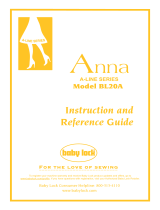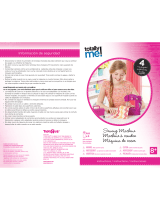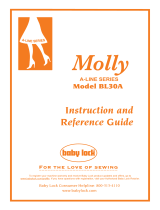
1
TABLE OF CONTENTS
SECTION 1. ESSENTIAL PARTS
Name of Parts .................................................................................................................................... 4
SECTION 2. GETTING READY TO SEW
Extension Table ................................................................................................................................. 6
Standard Accessories ........................................................................................................................ 6
Accessories Storage Box ................................................................................................................... 6
Connecting the Machine to the Power Supply ................................................................................... 8
Foot Control ....................................................................................................................................... 8
Presser Foot Lifter ............................................................................................................................. 10
To Attach and Remove the Presser Foot .......................................................................................... 10
Changing Needles ............................................................................................................................. 12
Thread and Needle Chart .................................................................................................................. 12
Setting Spool Pins ............................................................................................................................. 14
Removing or Inserting the Bobbin Case ............................................................................................ 14
Winding the Bobbin............................................................................................................................ 16
Threading Bobbin Case ..................................................................................................................... 16
Threading the Machine ...................................................................................................................... 18
Needle Threader (optional) ................................................................................................................ 20
Drawing Up Bobbin Thread ............................................................................................................... 20
Balancing Needle Thread Tension .................................................................................................... 22
Adjusting Bobbin Thread Tension ...................................................................................................... 22
Pattern Selector Dial .......................................................................................................................... 24
Stitch Length Dial ............................................................................................................................... 24
Reverse Stitch Button ........................................................................................................................ 26
Dropping the Feed Dog ..................................................................................................................... 26
SECTION 3. BASIC SEWING
Straight Stitch Sewing ........................................................................................................................ 28
To Change Sewing Direction ............................................................................................................. 28
Using the Seam Guides on the Needle Plate .................................................................................... 30
Turning Square Corners .................................................................................................................... 30
Zigzag Stitching ................................................................................................................................. 32
SECTION 4. UTILITY STITCHING
Overcasting ........................................................................................................................................ 32
Tricot Stitch ........................................................................................................................................ 34
Knit Stitch ........................................................................................................................................... 34
Straight Stretch Stitch ........................................................................................................................ 36
Sewing on Buttons ............................................................................................................................. 38
Buttonhole .......................................................................................................................................... 40
Corded Buttonhole ............................................................................................................................. 42
Zipper Application .............................................................................................................................. 44
Blind Stitch Hemming ........................................................................................................................ 46
SECTION 5. DECORATIVE STITCHING
Shell Tuck .......................................................................................................................................... 48
Stretch Stitch Patterns ....................................................................................................................... 48
Smocking ........................................................................................................................................... 50
Applique ............................................................................................................................................. 50
SECTION 6. CARE OF YOUR MACHINE
Dismantling and Assembling Hook Race Unit ................................................................................... 52
Cleaning the Feed Dog ...................................................................................................................... 52
Sewing Light ...................................................................................................................................... 54
Oil the Machine .................................................................................................................................. 54
Troubleshooting ................................................................................................................................. 56























